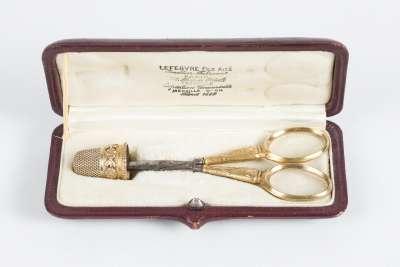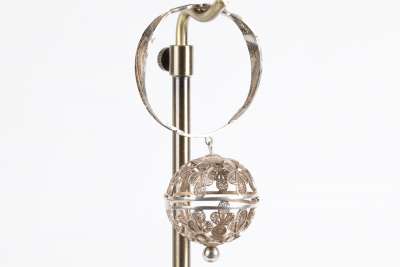This antique Dutch silver knitting needle holder dates from the period between 1814 and 1905, marked by the distinctive sword mark used during this time as the standard hallmark for articles of small size. The holder is crafted with precision, showcasing the meticulous silversmithing skills typical of Dutch artisans. The elongated form is sleek and elegant, measuring 26cm in length and 1.2cm in width. The silver material offers a timeless appeal, with subtle decorative elements that add to its historical charm. This piece is a testament to the practical yet beautifully designed tools used in the art of needlework and is highlighted in Kay Sullivan's book 'Needlework Tools and Accessories'.
Condition Report
The knitting needle holder is in a condition that reflects its age and historical usage. The silver surface displays minor wear, which is consistent with the passage of time and handling. This wear is typical for antique silver items and does not detract from the overall aesthetic or functionality of the piece. The hallmark is still legible, providing a clear indication of its Dutch origin and confirming its authenticity as a 19th-century artefact. The item shows no significant damages or repairs, making it a well-preserved example of its type.
Dimensions
Weight: 24gm, Length: 26cm, Width: 1.2cm.
A Collector's Essential Tool
Originally designed to hold knitting needles, this holder was an essential tool for knitters, safeguarding their needles and ensuring they remained in perfect condition between uses. The silver holder not only served a practical purpose but also reflected the owner's status and appreciation for beautifully crafted objects. In the 19th century, needlework was a valued skill, and tools such as this holder were treasured possessions, often passed down through generations as heirlooms.
Exemplary Dutch Craftsmanship
This knitting needle holder exemplifies Dutch silversmithing from the 19th century, a period renowned for its high quality and intricate craftsmanship. The simple yet elegant design reflects the practical aesthetic of the era, where form and function were harmoniously balanced. The use of silver was a mark of quality and durability, ensuring that such objects could be used over a long period while retaining their visual appeal. The sword hallmark is a testament to the piece's authenticity and the rigorous standards of Dutch silver production during this time.
The Art of Silver Crafting
Creating such a fine piece required skilled craftsmanship and knowledge of silver as a material. Silversmiths of the time would have employed techniques such as casting, engraving, and polishing to achieve the smooth finish and precise details seen on this knitting needle holder. The hallmarking process was essential, ensuring that the silver met the required standards and providing a traceable lineage for the item. This craftsmanship ensured both the functionality and the longevity of the holder, making it a durable tool for its original owner.
Produced by Skilled Dutch Silversmiths
The hallmark on this knitting needle holder indicates its creation by skilled Dutch silversmiths, who were known for their expertise in working with silver. The sword mark, used between 1814 and 1905, signifies not only the origin but also the quality of the craftsmanship. Dutch silversmiths were highly regarded for their ability to produce intricate and reliable tools and accessories, such as this needle holder, which served both practical and aesthetic purposes. This piece is a representation of the high standards and attention to detail characteristic of the silversmiths of the Netherlands during this era.
Admired by Collectors of Needlework Tools
Collectors of needlework tools and accessories highly value items like this knitting needle holder for their historical significance and craftsmanship. Such pieces offer insight into the daily lives and practices of people in the 19th century, particularly in the realm of textile arts. The combination of utility and artistry makes these tools appealing to collectors who appreciate both the history of needlework and the evolution of decorative arts. The mention in Kay Sullivan's 'Needlework Tools and Accessories' further cements its status as a noteworthy example for enthusiasts and historians alike.













